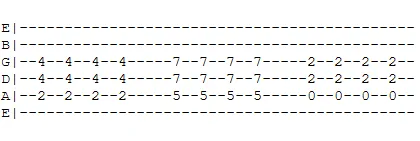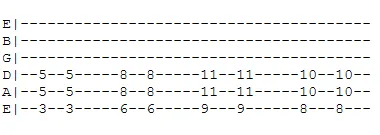Metal is a genre of music that has defined my musical tastes in many ways. I listen to a lot of classic rock, Mariachi and Spanish guitar music these days, but during my childhood metal was a regular part of my life’s soundtrack.
Writing this article has allowed me to revisit a lot of those songs that helped shape me and certainly brought back memories.
So enjoy this list of 11 metal chord progressions.
1. i5 II5 III5 VII5 I5 VII5 VI5
This metal chord progression is from “Holy Diver” by Dio. After writing an article about the best metal karaoke songs, I had a revival in my appreciation for Dio. I’ve actually added “Holy Diver” to my list of go-to karaoke songs.
Anyways, this chord progression is somewhat unique in that it completely avoids the use of the IV and V chords, while using every other chord in the key. Actually pretty cool, and obviously this song rocks.
Chords from the song: C5, D5, E flat 5, B flat 5, C5, B flat 5, A flat 5


2. VII I VII I
“War Pigs” by Black Sabbath is one of the most iconic metals songs ever written and it’s kind of a wonder that this chord progression is so simple. This is just chords from the verses.
Of course mixed in throughout the song is several riffs and other chord progressions, but this hard hitting progression of only two chords is certainly the most recognizable part of the song. In a genre full of shredding, sometimes you just need to keep things simple.
Chords from the song: D major, E major, D major, E major


3. I III VII III VII III I
A common theme in metal music is making a guitar riff sound thicker and louder by just making each note into a chord. That’s what’s happening here in “Metal Health (Bang Your Head)” by Quiet Riot.
Side note, this song brings back memories of riding in the car literally banging my head with my dad.
When you listen to the song, the main riff from the song just a slow, but powerful guitar riff. But it’s so thick and powerful because they just make each note a giant major chord.
Chords from the song: A major, C major, G major, C major, G major, C major, A major


4. I III I V flatV IV
Metallica is perhaps the band that had the most success crossing from pure metal into popular music. “Enter Sandman,” “The Unforgiven,” and “Fuel,” which this chord progression is from, all seemed to break out of metal and enter into the generic rock category.
Now some classic rock stations will even play Metallica songs from time to time. Anyways, this song displays another common theme in metal, which is the use of half step intervals as go between notes. The V, flat V and IV chords are really just a chromatic walk from V to IV, and this is something you’ll see commonly in metal music.
Chords from the song: E flat major, G flat major, E flat major, B flat major, A major, A flat major


5. i VII i VII VI VII i
“The Trooper” by Iron Maiden was one of the songs that helped define the metal genre. And this chord progression is from the verses.
The fast tempo, the crazy guitar licks that are basically like constant little guitar solos, and the screaming high vocals with the signature metal vibrato. All these things create a metal masterpiece that has stood the test of time.
Chords from the song: E minor, D major, E minor, D major, C major, D major, E minor


6. I II I II
I’m a huge fan of comedy music, from Flight of the Conchords to Lonely Island, I just love music that doesn’t take itself too seriously. But the king of comedy music is Tenacious D. This is from their heaviest song “The Metal.”
And while it’s a funny song, it freaking rocks.
It actually displays another common theme in metal music: the I chord with the chord a half step above it. Typically, the II chord is a whole step above the root note, but in this case I’m calling the II the chord only half a step above the root.
Chords from the song: E major, F major, E major, F major


7. I5 III5 VII5
This metal chord progression comes from the verse of “Madhouse” by Anthrax. The real star of this song is the guitar riffs that fall between verses and choruses, but the foundation is this chord progression.
This song again showcases the heavy use of the VII chord in metal music. One thing to note while listening to this one is that guitar riffs are often mixed in with the chord progressions. Hit a chord, then riff into the next chord. This is super common in metal.
Chords from the song: B5, D5, A5


8. i VII VII i
This is from “Chop Suey” by System of a Down, and this chord progression is another example of the use of half step intervals in metal where other genres would use a whole step. This is taken from the verses.
Again, using the VII chord, but normally the VII is a whole step below the I and in this case it’s only a half step down. I feel like this is one way to create a little bit more dissonance in the song, which often creates a feeling of
Chords from the song: G minor, F sharp major, F sharp major, G minor


9. i5 VI5 iv5 III5 iv5 v5 iv5 i5
This metal chord progression comes from “Pretelethal” by Coheed and Cambria. They are one of my favorite modern rock groups in recent memory. I’m a sucker for science fiction and they weave science fiction into everything they write.
Related List: 9 Ominous Chord Progressions
Why?
Well you could reasonably call this song part of a soundtrack. The singer from Coheed and Cambria has also created a sci-fi comic book series called Amory Wars. And the band’s albums follow the events in the comic series. I think it’s pretty awesome, and the comic is legitimately good.
Chords from the song: E5, C5, A5, G5, A5, B5, A5, E5
10. I VII IV VII IV
Sometimes the line between metal and rock gets a bit blurred. This chord progression comes from “Thunderstruck” by AC/DC, and while you may debate whether or not this is a metal song or not, there’s no denying how hard this song rocks.
One of the most iconic guitar riffs ever, energetic vocals, and this chord progression from the chorus make this song one of the biggest bangers ever produced.
Chords from the song: B major, A major, E major, A major, E major


11. I5 III5 FlatV5 IV5
This is taken from one of those chord progressions that everyone learns when they first pick up a guitar. It’s from the main riff of “Smoke on the Water” by Deep Purple.
If you’re a guitar player, chances are you already know this one, but it felt wrong to write a metal chord progression article without including the most well known metal chord progression.
Chords from the song: G5, B flat 5, D flat 5, C5


Writing Metal Music
It shouldn’t surprise you that a chord progression isn’t enough to write a certain style of music. You can find I, IV, V chord progressions in virtually every style of music, but that doesn’t make funk music sound like folk music. There are differences in how those chords are played, and that’s what separates musical styles.
When I write these chord progression articles I try to take note of some of the most common things I see in the songs that separate them from music of other genres.
Here is my list for metal:
- Playing riffs with chords – Often a chord progression is really just a guitar riff, but playing each note as a chord makes it sound thicker.
- Chromatic walks – Metal doesn’t like to stick within the key. You’ll often hear half step intervals between chords that create a little extra dissonance.
- I and VII chords – I didn’t realize this until I wrote the article, but the VII chord is used a ton in metal.
- Regular riffs – You’ll often hear riffs in between chord changes in metal music.
- Lots of distortion – This probably goes without saying, but metal uses distorted guitars almost exclusively.
- Fast tempos – Another gimme, but yeah metal bands like to play fast.
There’s always lots of room to add your own unique flair within a genre, but hopefully these chord progressions and themes will give you enough inspiration to break through your writing block.
